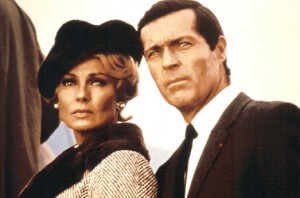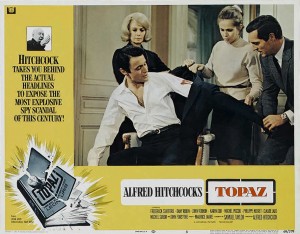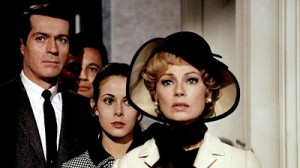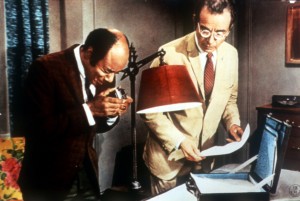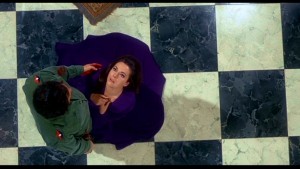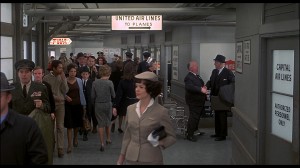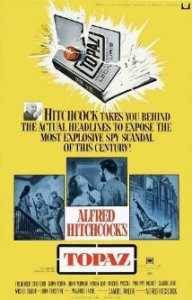Topaz **** (1969, Frederick Stafford, Dany Robin, John Vernon, John Forsythe, Philippe Noiret) – Classic Movie Review 463
Alfred Hitchcock’s 1969 spy thriller Topaz is one of his least interesting films, despite being based Leon Uris’s top bestselling novel. But it remains entirely watchable thanks some fine performances and a few typical Hitchcock touches.
Despite being based Leon Uris’s top bestselling spy thriller novel material, Alfred Hitchcock’s 1969 effort Topaz proves to be one of his least interesting films. You can’t help feeling that it should have engaged his imagination as a movie more. Believed to have been forced on him by the studio, it was one his unhappiest directing experiences.
In the lead role, Frederick Stafford is uninspired as André Devereaux, a French spy recruited by John Forsythe’s CIA man Michael Nordstrom to smash a Russian espionage outfit in Cuba in 1962. Nordstrom interviews a high-ranking Russian official who defects to the United States. After the defector reveals that a French spy ring codenamed Topaz is passing NATO secrets to the Russians, Nordstrom calls in his buddy Devereaux to try to expose the spies.
It should be ideal material for Hitchcock, but Topaz is dimmed by dull playing from an interesting non-starry cast of normally good actors who are in many cases ineffectual here, many unconvincing scenes and a feeling throughout of nervous hesitation that’s odd in a director who was normally so sure of his effects. It’s a pity that Sean Connery turned down the lead because that might have given the film the boost it needs.
Nevertheless, moderate though Topaz is, it’s still a must for Hitchcock’s fans, and it remains entirely, if only sporadically, watchable. That is almost entirely thanks to a handful of notable high points like fine performances from Roscoe Lee Browne as Philippe Dubois and Philippe Noiret as Henri Jarre, plus the smart start as a Russian scientist defects in Copenhagen, as well as a few typical Hitchcock arresting visual flourishes and clever touches like a dead woman’s purple dress spilling out like her blood across the floor.
Typically, Hitchcock tried to experiment, revealing the plot not only though the script but also through the use of colours, mostly red, yellow and white. The full version runs an overlong
The story behind the film’s more interesting than the movie, unfortunately.
An unusually dithering Hitchcock shot three endings, all of which were used in different releases, and a video version and a laserdisc show all three. The ending with an old-fashioned pistol duel between André and Jacques in a French football stadium was the original one. This scene was not in the book, but Hitchcock planned it from the start. After finishing principal photography in March, the director took a break, then returned in Paris in mid-April to shoot the climax.
But half way through the week-long shoot, Hitchcock had to leave for America because his wife Alma was taken to hospital. He gave his associate producer Herbert Coleman precise instructions how to shoot rest of the scenes in the duel ending. But in the final cut, the editing of the sequence was a sore point to Hitchcock.
Test screening audiences hated the duel ending and complained the film was far too long. So Hitchcock shot a second ending he liked better, with Jacques escaping on an Aeroflot flight to the Soviet Union as André and Nicole board their adjacent Pan Am flight back to the US. But confused preview audiences did not like this either.
So Hitchcock used existing footage to create a third ending in which Granville is exposed and expelled from a NATO meeting. A gunshot tells he commits suicide behind his drawn curtains since there was no footage of his suicide.
The film was released with this third ending and cut by nearly 20 minutes to 127 minutes. The 143-minute cut with the second ending in which Jacques escapes was released for the first time by Universal on DVD in 1999.
Hitchcock appears in his usual cameo about 30 minutes in at the airport getting out of a wheelchair.
Hitchcock won the National Board of Review award for Best Director and Philippe Noiret won for Best Supporting Actor.
The cast are Frederick Stafford as André Devereaux, Dany Robin as Nicole Devereaux, Karin Dor as Juanita de Cordoba, John Vernon as Rico Parra, Claude Jade as Michèle Picard, Michel Subor as François Picard, Michel Piccoli as Jacques Granville, Philippe Noiret as Henri Jarré, Roscoe Lee Browne as Philippe Dubois, Per-Axel Arosenius as Boris Kusenov, John Forsythe as Michael Nordstrom, Edmon Ryan as McKittreck, Sonja Kolthoff as Mrs. Kusenov, Tina Hedström as Tamara Kusenov, John van Dreelen as Claude Martin, Donald Randolph as Luis Uribe, Roberto Contreras as Muñoz, Carlos Rivas as Hernandez, Roger Til as Jean Chabrier, Lewis Charles as Pablo Mendoza, Sándor Szabó as Emile Redon, Anna Navarro as Carlotta Mendoza, Lew Brown as American Official, John Roper as Thomas, George Skaff as René d’Arcy, Ann Doran as Mrs Foryth and Eva Wilma as Rosita Gomez.
© Derek Winnert 2013 Classic Movie Review 463
Check out more reviews on http://derekwinnert.com/

